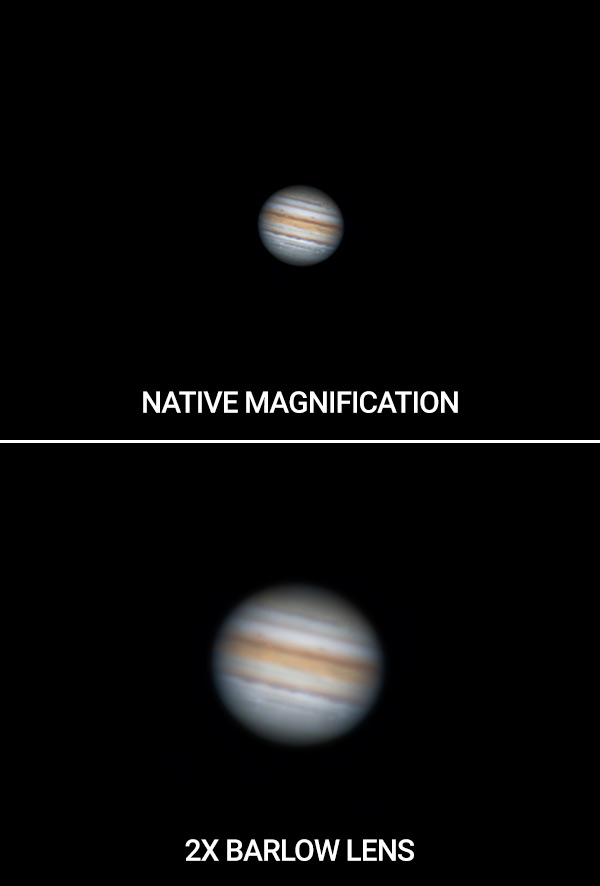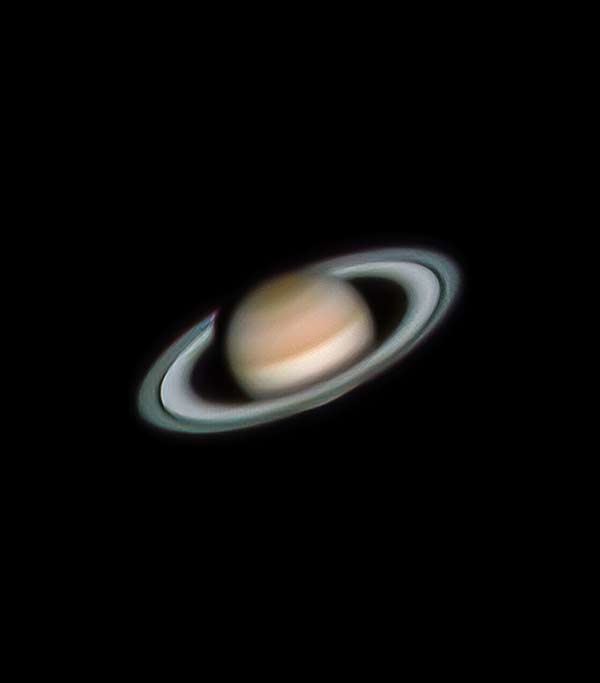How to Use a Barlow Lens
A Barlow lens, named after mathematician Peter Barlow, is an optical instrument used to increase the magnification of your eyepiece for visual astronomy, or extend the focal length of your telescope for astrophotography.
Most commonly, it is placed between the eyepiece and the diagonal for visual astronomy, and between the camera and the focuser tube for astrophotography.
They come in varying degrees of magnification factors (usually between 2X and 5X) and will increase the magnification for any eyepiece placed in front of the Barlow lens.
I often use a Barlow lens with my dedicated astronomy camera when photographing planets.
How does a Barlow lens work?
Simply put, a Barlow lens increases the effective focal length of the telescope. It does this by diverging light before it enters the eyepiece, which increases the magnification of the image.
A Barlow Lens can double the magnification of your view. However, the image will be less sharp.
Each lens has a fixed magnification factor (i.e. 1X, 2X etc.) and this is multiplied by the magnification of the eyepiece, resulting in an overall magnification. If you would like to see the exact magnification your telescope and Barlow lens can achieve, be sure to check out this handy telescope magnification calculator from Sky and Telescope.
| Eyepiece | Focal Length | F-Ratio | Barlow lens | Total Magnification |
|---|---|---|---|---|
| 10 mm | 1000 | 6 | 1X | 600X |
| 10 mm | 1000 | 6 | 2X | 1200X |
| 24 mm | 1000 | 6 | 1X | 250X |
| 24 mm | 1000 | 6 | 2X | 500X |
Chart showing the increase in magnification between two different eyepieces
For a more mathematical explanation of how a Barlow lens works, check out this post.
How to use a Barlow lens
You will be happy to know that a Barlow lens is easy to use. As mentioned above, it sits between the eyepiece and the focuser. So before inserting your eyepiece, you will add your Barlow lens and then insert your eyepiece into the Barlow lens.
- Select your eyepiece
- Place the Barlow into the focuser of the telescope, secure it in place
- Insert the eyepiece into the Barlow, secure it in place
- Use the focuser to adjust focus of the telescope until clear
- Enjoy your views
Some telescopes, such as refractors and SCTs, which typically use a diagonal, allow you to change the order of the optical train. Rather than placing the Barlow into the focuser, you have the option of putting the diagonal in the Barlow and the Barlow into the focuser. This would mean that the position of eyepiece would not change and would be placed into the diagonal.
Given the change in Barlow’s position, this will change the magnification factor, as discussed above.
When to use a Barlow lens
This type of lens can be a great tool for astronomy/astrophotography. You may want to consider adding one to your set up if you want to:
- Increase magnification: a Barlow lens is a great option if you don’t have an eyepiece at the level of magnification you want. Adding a 2X or 3X Barlow will give you an increase in magnification to see different objects.
- Increase your eyepiece collection: combining a Barlow with your varying eyepieces will allow you to get more out of your eyepiece collection, giving you more magnification options when combined. When compared to the cost of buying multiple eyepieces, the cost of buying a Barlow lens to combine with your current eyepiece collection will be significantly less.
- Maintain eye relief of certain eyepieces: many high-powered eyepieces do not offer a great deal of eye relief requiring the user to place their eye very close to the eyepiece. A Barlow, paired with a lower magnification eyepiece, will allow for greater eye relief for the user, which can be particularly beneficial for glasses wearers or children.
Though there are several benefits to using a Barlow lens, there are a few things you may want to consider:
- Dimmer views: though optics have come a long way to allow for more transmission of light, the more layers of lens elements (i.e. glass) in a Barlow lens can produce dimmer views. This can be particularly noticeable if you have a slower (higher f-stop) telescope.
- Great magnification isn’t always better: a Barlow lens will increase the magnification of your object, but also any turbulence that may be present. This may result in blurrier views while observing.
- Possibility of vignetting: any time you change an optical system, it is possible that you introduce new issues, such as vignetting.
The planet Saturn photographed using a 2X Barlow lens in front of the camera.
Which Barlow lens should I buy?
When buying a Barlow lens, be sure to buy the correct size to fit the tubes of your existing eyepieces (i.e. 1.25 or 2 inch etc.).
If you are looking to extend your eyepiece collection, you will also want to consider the eyepieces you currently own and their level of magnification once paired with a 2X or 3X Barlow. This will give you a strategy to work with to ensure you have a variety of different magnifications.
The Celestron OMNI 2X Barlow Lens is affordable and works well.
As mentioned above, the focal ratio of your telescope will also help determine the level of magnification you should get. A slower focal ratio telescope (i.e. f/10) will not need a 3X Barlow, though a faster focal ratio (i.e. f/5) could accommodate a 4X Barlow. For this reason, you will find that the lower magnification (i.e. 1X – 3X) Barlow lenses are more versatile.
Here are some Barlow lenses that I have personally used:
Astromania 2″ 2X Barlow Lens
Video
The following video explains how to use a Barlow Lens and why it is an essential telescope accessory for visual observers.




